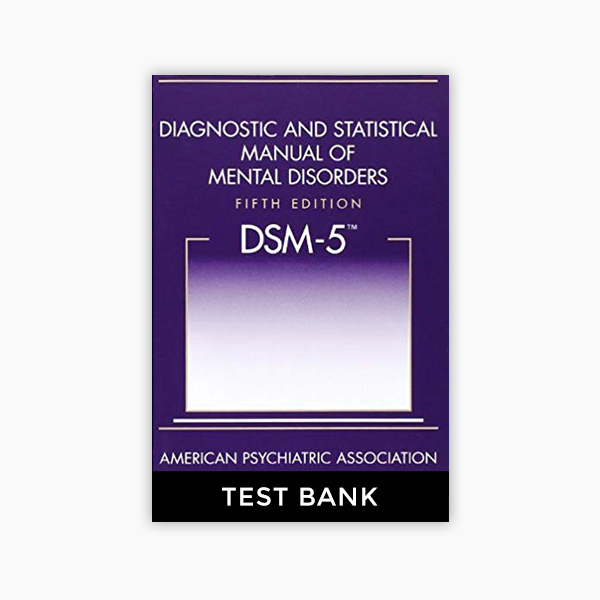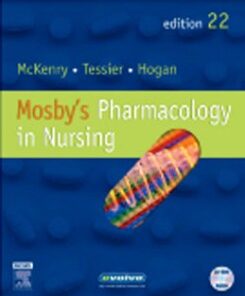DSM5 Diagnostic and Statistical Manual of Mental Disorders 5th Edition Test Bank
$35.00
DSM5 Diagnostic and Statistical Manual of Mental Disorders 5th Edition Test Bank
DSM5 Diagnostic and Statistical Manual of Mental Disorders 5th Edition Test Bank
Chapter 1 Introduction
MULTIPLE CHOICE
1. Which understanding is the basis for the nursing actions focused on minimizing mental health
promotion of families with chronically mentally ill members?
a. Family members are at an increased risk for mental illness.
b. The mental health care system is not prepared to deal with family crises.
c. Family members are seldom prepared to cope with a chronically ill individual.
d. The chronically mentally ill receive care best when delivered in a formal setting.
ANS: A
When families live with a dominant member who has a persistent and severe mental disorder the
outcomes are often expressed as family members who are at increased risk for physical and
mental illnesses. The remaining options are not necessarily true.
2. Which nursing activity shows the nurse actively engaged in the primary prevention of mental
disorders?
a. Providing a patient, whose depression is well managed, with medication on time
b. Making regular follow-up visits to a new mother at risk for post-partum
depression
c. Providing the family of a patient, diagnosed with depression, information on
suicide prevention
d. Assisting a patient who has obsessive compulsive tendencies prepare and
practice for a job interview
ANS: B
Primary prevention helps to reduce the occurrence of mental disorders by staying involved with a
patient. Providing medication and information on existing illnesses are examples of secondary
prevention which helps to reduce the prevalence of mental disorders. Assisting a mentally ill
patient with preparation for a job interview is tertiary prevention since it involves rehabilitation.
3. Which intervention reflects attention being focused on the patients intentions regarding his
diagnosis of severe depression?
a. Being placed on suicide precautions
b. Encouraging visits by his family members
c. Receiving a combination of medications to address his emotional needs
d. Being asked to decide where he will attend his prescribed therapy sessions
ANS: D
A primary factor in patient treatment includes consideration of the patients intentions regarding
his or her own care. Patients are central to the process that determines their care as their abilities
allow. Under the guidance of PMH nurses and other mental health personnel, patients are
encouraged to make decisions and to actively engage in their own treatment plans to meet their
needs. The remaining options are focused on specifics of the determined plan of care.
4. When a patients family asks why their chronically mentally ill adult child is being discharged
to a community-based living facility, the nurse responds:
a. It is a way to meet the need for social support.
b. It is too expensive to keep stabilized patients in acute care settings.
c. This type of facility will provide the specialized care that is needed.
d. Being out in the community will help provide hope and purpose for living.
ANS: D
Hospitalization may be necessary for acute care, but, when patients are stabilized, they move into
community-based, patient-centered settings or are discharged home with continued outpatient
treatment in the community. Concentrated efforts are made to reduce the patients sick role by
providing opportunities for the development of a purposeful life and instilling hope for each
patients future. Although social support is important, such a living arrangement is not the only
way to achieve it. Although acute care is expensive, it is not the major concern when determining
long-term care options. Community-based facilities are not the only option for specialized care.
5. What is the best explanation to offer when the mother of a chronically ill teenage patient asks,
Under what circumstances would he be considered incompetent?
a. When you can provide the court with enough evidence to show that he is not
able to care for himself safely.
b. It is not likely that someone his age would be determined to be incompetent
regardless of his mental condition.
c. He would have to engage in behavior that would result in harm to himself or to
someone else; like you or his siblings.
d. If the illness becomes so severe that his judgment is impaired to the point where
the decisions he makes are harmful to himself or to others.
ANS: D
When a person is unable to cognitively process information or to make decisions about his or her
own welfare, the person may be determined to be mentally incompetent. Providing self-care is
not the only criteria considered. Age is not a factor considered. The decision is often based on
the potential for such behavior.
6. Which psychiatric nursing intervention shows an understanding of integrated care?
a. A chronically abused woman is assessed for anxiety.
b. A manic patient is taken to the gym to use the exercise equipment.
c. The older adult diagnosed with depression is monitored for suicidal ideations.
d. A teenager who refuses to obey the units rules is not allow to play video games.
ANS: A
The majority of health disciplines now recognize that mental disorders and physical illnesses are
closely linked. The presence of a mental disorder increases the risk for the development of
physical illnesses and vice versa. Assessing a chronically abused individual for anxiety call
should attention to the psychiatric disorder that could develop from the abuse. The remaining
options show interventions that are appropriate for the mental disorder.
7. What reason does the nurse give the patient for the emphasis and attention being paid to the
recovery phase of their treatment plan?
a. Recovery care, even when intensive, is less expensive than acute psychiatric
care.
b. Effective recovery care is likely to result in fewer relapses and subsequent
hospitalizations.
c. Planning for recovery care is time consuming and involves dealing with many
complicated details.
d. Recovery care is usually done on an outpatient basis and so is generally better
accepted by patients.
ANS: B
Much attention is paid to recovery care since effective recovery care helps improve patient
outcomes and thus minimize subsequent hospitalizations. Recovery care is not necessarily less
expensive than acute care. Although effective recovery care planning may be time consuming
and detail oriented, that is not the reason for implementing it. Recovery care is not necessarily
well accepted by patients.
8. The nurse is attending a neighborhood meeting where a half-way house is being proposed for
the neighborhood when a member of the community states, We dont want the facility; we
especially dont want violent people living near us. The response by the nurse that best addresses
the publics concern is:
a. In truth, most individuals with psychiatric disorder are passive and withdrawn
and pose little threat to those around them.
b. The mentally ill seldom behave in the manner they are portrayed by movies; they
are people just like the rest of us.
c. Patients with psychiatric disorder are so well medicated that they do not display
violent behaviors.
d. The mentally ill deserve a safe, comfortable place to live among people who
truly care for them.
ANS: A
A major reason for the existence of the stigma placed on persons with mental illness is lack of
knowledge. The main fear is of violence, although only a small percentage of patients with
mental illness display this behavior. Providing the public with accurate information can help
reduce stigma. The remaining options do not directly address the concerns stated.
9. Which activity shows that a therapeutic alliance has been established between the nurse and
patient?
a. The nurse respects the patients right to privacy when visitors are spending time
with the patient.
b. The patient is eagerly attending all group sessions and working independently on
identifying their personal stressors.
c. The patient is freely describing their feelings related to the physical and
emotional trauma they experienced as a child with the nurse.
d. The nurse dutifully administers the patients medications on time and with
appropriate knowledge of the potential side effects.
ANS: C
A primary aspect of working with patients in any setting and particularly in the psychiatric
setting is the development of a therapeutic alliance with the patient. Such an alliance is
established on trust. It is a professional bond between the nurse and the patient that serves as a
vehicle for patients to freely discuss their needs and problems in the absence of the nurses
criticism or judgment. Any nurse has an obligation to respect the patients rights and administer
care effectively. The patients willingness to participate in the plan of care reflects self
motivation.
10. Mental health care reform has called for parity between psychiatric and medical diagnoses.
Which is an example of such parity?
a. Depression treatment is not paid for as readily as is treatment for asthma.
b. The mentally ill patient will be protected by law against social stigma.
c. Medical practitioners are trained to be proficient at treating mental disorders.
d. Psychiatric service reimbursement will be equivalent to that of medical services.
ANS: D
The term parity as used here refers to payments for mental health services that equal payment
schedules for medical or surgical conditions. The remaining options(B and C) do not relate to
financial reimbursement or funds allocated for mental health care being equal to those of medical
diagnoses.
MULTIPLE RESPONSE
1. Which assessment findings suggest to the nurse that this patient has characteristics seen in an
individual who has reached self-actualization? Select all that apply.
a. Reports to have, found peace and security in my religious faith
b. Effectively changed occupations when a chronic vision problem worsened
c. Has consistently earned a six-figure salary as an architect for the last 10 years
d. Has been in a supportive, loving relationship with the same individual for 15
years
e. Provides free literacy tutoring help at the local homeless shelter 3 evenings a
week
ANS: A, B, D, E Characteristics of self actualization would include: spiritual well-being, open
and flexible, relationally fulfilled, and generosity toward others. Salary doesnt necessarily reflect
self-actualization.
2. Which nursing activities represent the tertiary level of mental health care? Select all that
apply.
a. Providing a depression screening at a local college
b. Helping a mental-challenged patient learn to make correct change
c. Reporting an incidence of possible elder abuse to the appropriate legal agency
d. Regularly assessing a patients understanding of their prescribed antidepressants
e. Providing a 6-week parenting class to teenage parents through a local high
school
ANS: B, D Tertiary prevention reduces the residual effects of the disorder such as depression and
mental retardation. There is no quaternary level of prevention. Primary prevention reduces
occurrences of mental disorders such as screenings and parenting classes, and secondary
prevention reduces the prevalence of disorders as evidenced by assessing knowledge.
3. Which nursing actions indicate an understanding of the priority issues currently facing
psychiatric mental health nursing today? Select all that apply.
a. Working on the facilitys Safe Use of Restraints Policy revision committee
b. Advocating for increased salaries for all levels of psychiatric mental health
nurses
c. Attending a political rally for increased state funding for mental health service
providers
d. Offering an in-service to facility staff regarding the cultural implications of
caring for the Hispanic patient
e. Joining the state nursing committee working on the role and scope of practice of
the advanced practice psychiatric nurse
ANS: A, C, D, E Priority issues include funding, safety issues in psychiatric treatment
centersparticularly the use of patient restraints, quality-of-care issues, access to health care for
minority populations, and standardization of advanced practice nurse roles.
4. Which assessment findings describe risk factors that increase the potential risk for mental
illness? Select all that apply.
a. Possesses high tolerance for stress
b. Is very curious about how things work
c. Admits to being a member of an ethnic gang
d. Only practicing Jew among school classmates
e. Has a younger sibling who is mentally challenged
ANS: C, D, E Risk factors are internal predisposing characteristics and external influences that
increase a persons vulnerability and potential for developing mental disorders. Types of risk
factors and examples include the following: having a mentally-challenged family member in the
home; belonging to a punitive gang; and being the object of reject or bullying. The remaining
options are protective factors.
5. Which nursing actions show a focus on the fundamental goals that guide psychiatric mental
health nurses in providing patient care? Select all that apply.
a. Offering an informational session of identifying signs of depression at a local
senior center
b. Attending a workshop on evidence practice interventions for the chronically
depressed patient
c. Keeping strict but appropriate boundaries with a patient diagnosed with a
personality disorder
d. Asking a parent who has just experienced the death of a child if they could
consider talking with a grief counselor
e. Identifying what help a patient diagnosed with Alzheimers disease will need
with instrumental activities of daily living (IADLs)
ANS: A, B, D, E Standard objectives guide PMH nurses and members of related disciplines in
the care of patients (individuals, families, communities, and organizations). The objectives and
criteria are as follows: the promotion and protection of mental health, the prevention of mental
disorders, the treatment of mental disorders, and recovery and rehabilitation. Keeping
appropriate boundaries is a generalized nursing responsibility.












Reviews
There are no reviews yet.